USPS Change of Address and Name (Mail Forwarding Guide)

Changing your address with USPS seems easy. Enter your old and new address, and mail gets forwarded. But it's trickier when names come into play.
Nicknames, suffixes, hyphenations. Legal name changes due to marriage or divorce. One mismatch, and your mail's gone.
USPS doesn't know the same person might get mail under different names:
- Nicky and Nicole
- Maiden and married names
The system won't "figure it out." It expects precision.
USPS ignores names… until you move
By default, USPS delivers based on address, not name.
If you've changed your name but haven't moved, you don't need to notify USPS. Mail sent to your old or new name will still get delivered.
But moving changes everything.
Once you file a change of address (COA) with USPS, delivery switches from address-based to name-based.
There's a smarter way to handle address changes and name variations. One that works within USPS's rigid system.
Most people miss it. Let's make sure you don't.
Family vs individual: Avoid the multiplier effect

You can file a change of address with USPS as:
- A family: one form for everyone with the same last name
- An individual: one form per person
You can only file as a family if everyone with the same last name is changing to the same address. If someone with that name stays or moves elsewhere, file individually.
Family forwarding (preferred)
It's easier to forward mail as a family:
- Family forwarding only matches your last name.
- Individual forwarding matches your first and last name.
Both ignore:
- Middle names
- Titles like Mr., Ms., Mrs., and Dr.
But suffixes like Jr., Sr., II, and MD are matched.

Here's the trick…
If no one else at your address shares your last name, you're a family of one. So skip individual forwarding and file as a family instead.
Individual forwarding (like punishment)
Individual forwarding requires a separate change of address for each first name variation:
- Liz Smith (COA #1)
- Lizzie Smith (COA #2)
- Elizabeth Smith (COA #3)
If Ms. Smith changes her name to Mrs. Mitchell, she's suddenly filing six forms:
- Liz Mitchell (COA #4)
- Lizzie Mitchell (COA #5)
- Elizabeth Mitchell (COA #6)
Here's where it gets expensive:
- 6 COAs × $1.25 verification fee = $7.50
- 6 COAs × $44.50 for 18-month extensions = $267.00
Another surname? Nickname? Liza? Beth? It snowballs fast.

Individual forwarding is the misery option. You're stuck with it when someone else at your address shares your last name, isn't moving, and ruins family forwarding.
It's bloated, it's messier, and it sucks.
Think you're immune? Your name's Lia. The jury duty summons says "Li." One letter off. One missed notice. Individual forwarding fails you.
Can I really count as a "family" if it's just me?
Yes. You're a family of one.

Say you live with 10 people: roommates, relatives, or both. If no one else shares your last name, you can file a family change of address for yourself.
It only forwards your mail, not theirs.
I'm changing my name. How does this help me?
Here's the second trick: You can file more than one family change of address:
- One for your old last name
- Another for your new last name
- Heck, one for any prior last name… or future last name
Surely you can't give USPS a future name before you've changed it?
Sure you can… as long as you file online. They don't verify names there. File in person, though, and you'll need matching ID or proof of the name change.
And here's trick number three…
Family COAs ignore first names. Liz, Lizzie, Elizabeth? Doesn't matter. That multiplier only hits individual COAs.
What about hyphenated names?
If you have a hyphenated last name or double last name, file a change of address for your full surname and each part.

For example, if your last name is Lee-Sanchez, file 3 COAs:
- Your hyphenated name (Lee-Sanchez)
- Just Lee
- Just Sanchez
Filing a change of address (and name too)

You can change your address with USPS in two ways:
- In person at a post office
- Online using the USPS website
One might break your spirit. The other's silky-smooth.
1. Filing in person (almost all downside)
Pick up a free Mover's Guide packet at any post office.
- Check in the lobby, near the brochures.
- Otherwise behind the counter. Just ask the clerk.
You can't download or print a PDF of the Mover's Guide. You'll need the real packet from the post office.
Heads up: Some post offices dumped the paper packet. They'll tell you to file online.

Here's what the official USPS Mover's Guide looks like. These scans are for reference only.
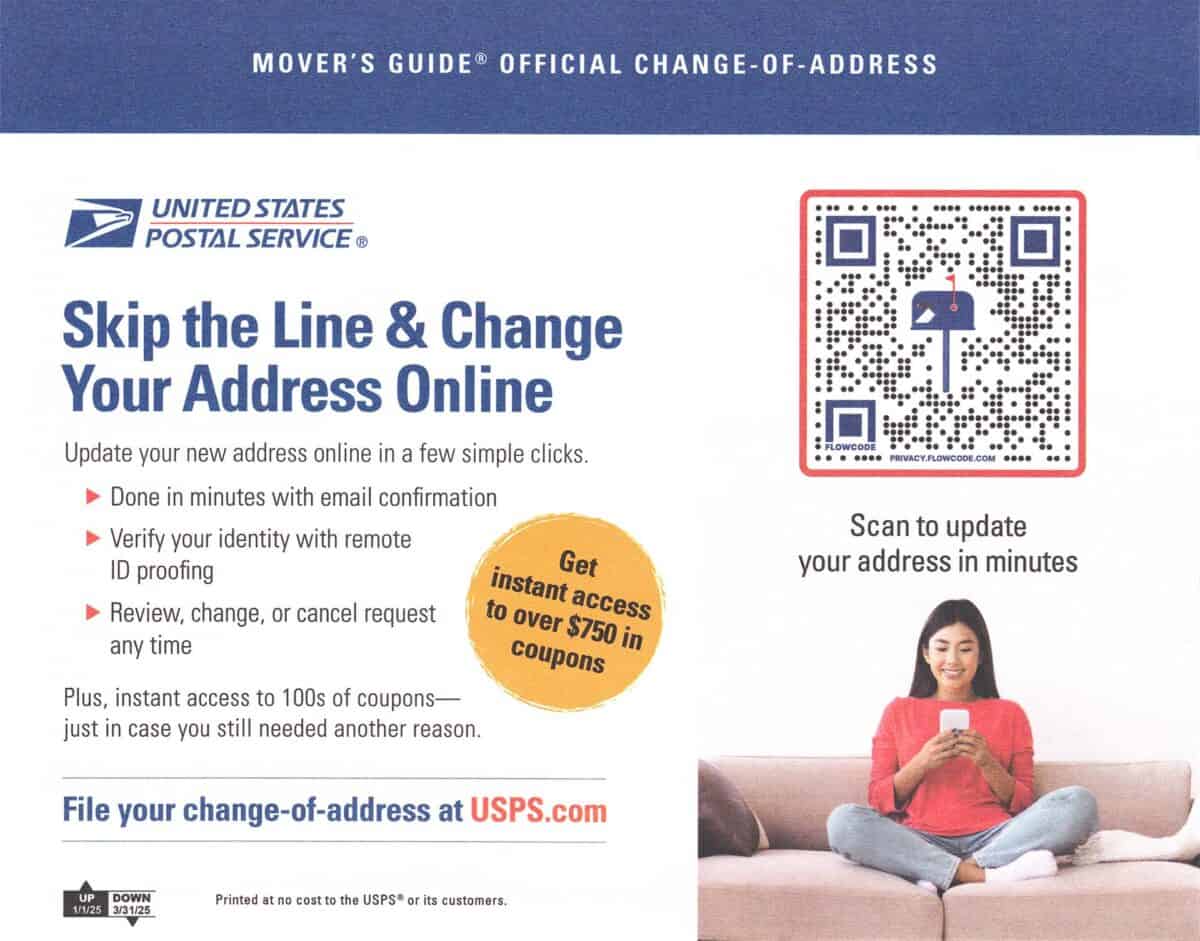
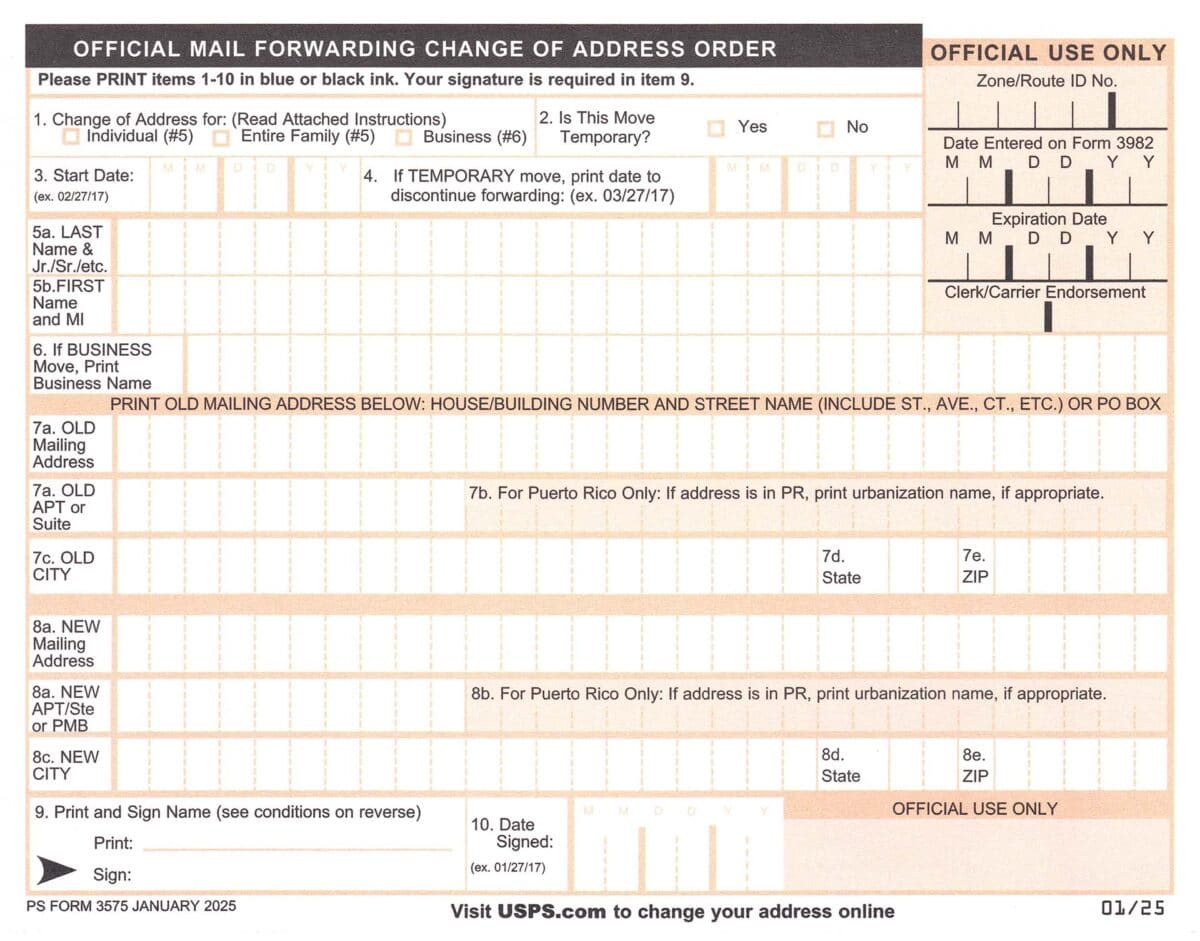
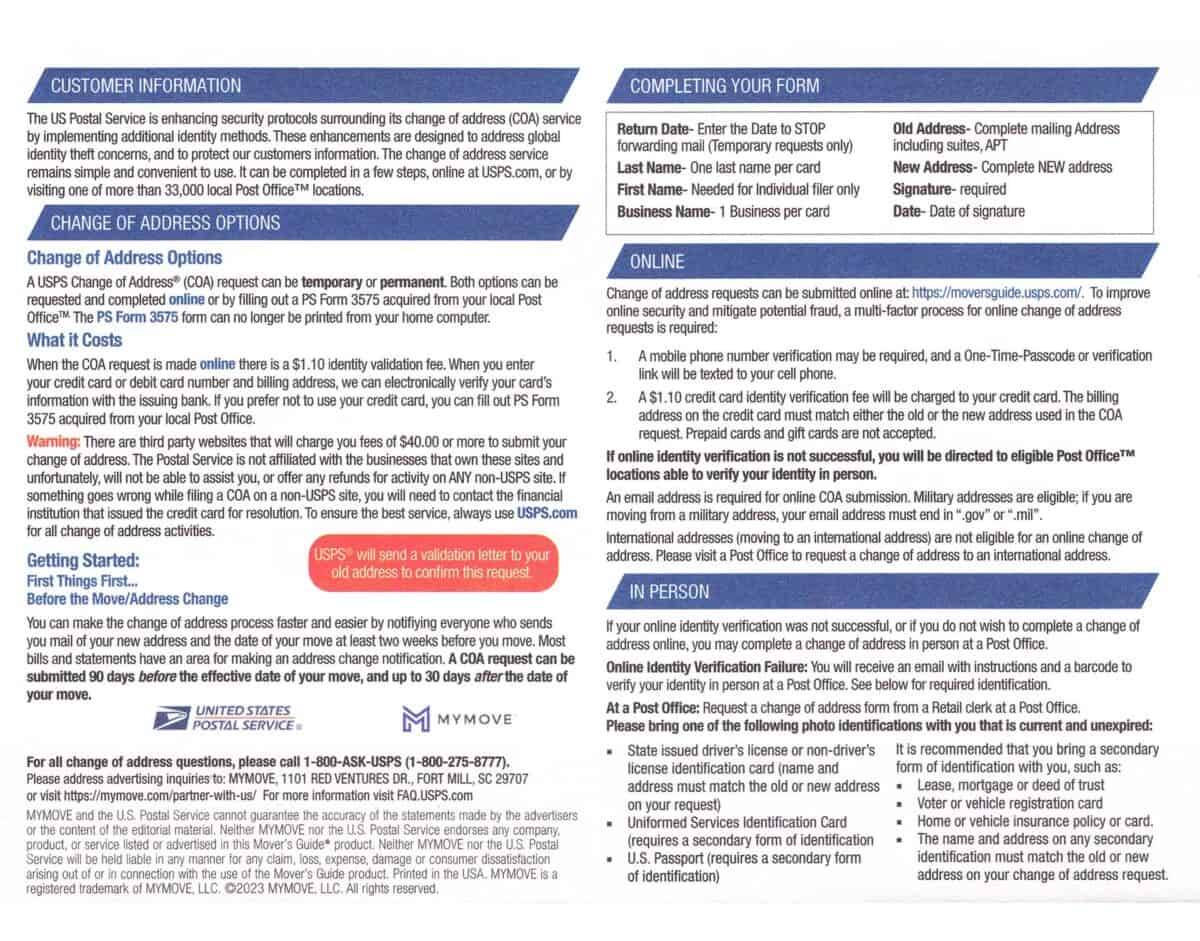
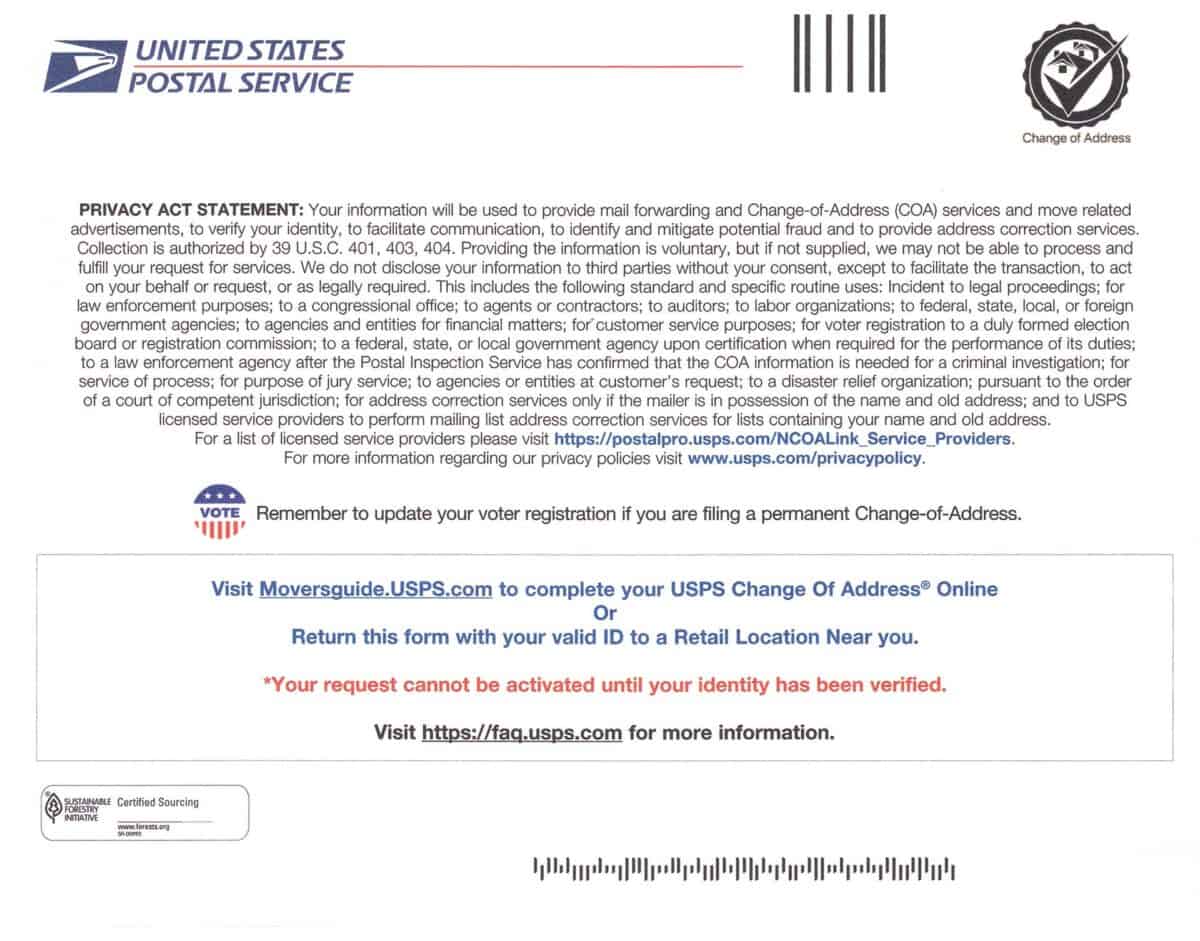
Inside the packet, fill out PS Form 3575 and hand it to the clerk.
Wait! What happened to filing by mail?
Mail filing ended in July 2023 to fight identity theft.
- Now it's all in person.
- And, yes, it's awful.
Still, in-person filing has its perks:
- No verification fees
- No internet, email, or phone required
That comes in handy when helping Auntie Landline or Uncle Off-the-Grid, out in the Land of No Wi-Fi and Spotty 3G.
But in-person filing means you'll need to:
- Show primary photo ID
- Show secondary ID (in some cases)
- Show proof of name change if your ID doesn't match
Bring unexpired photo ID:
- Driver's license
- State-issued non-driver ID card
- Military ID
- Tribal ID
- Green card
- U.S. passport
If your primary ID lacks an address or shows neither your old nor new address, bring secondary ID with either address:
- Deed, mortgage, or lease
- Voter or vehicle registration
- Home or car insurance policy or card
Finally, the name change bomb…
If your ID doesn't match the name on your COA (say, maiden vs married), bring proof of the name change:
- Marriage certificate
- Divorce decree
- Court order

This is crazy. This is too much work.
Agreed. Skip the IDs, the counter. Just file online.
2. Filing online (because why wouldn't you?)
To file a change of address online via USPS Change-of-Address, you'll need:
- Mobile phone number: to get a verification text (okay to delete afterward)
- Email address: to get a confirmation code (hold on to this)
- Credit or debit card: for the $1.25 identity verification fee (nonrefundable)
That $1.25 fee just checks that the cardholder's billing address matches the old or new address on the COA.
Unlike filing in person, USPS doesn't verify names when you file online. No need to show ID, scan anything, or upload proof of a name change.

Now you're ready to rock and roll… Imagine you had two COAs to file:
- One for your maiden name
- One for your new married name
First COA? Got the text, code, paid the fee. Easy.
Time for COA #2… Then it hits you:
Oh no. I only have one email and phone number.
Now what?
- Make a throwaway Gmail account?
- Ask a friend to take your text?
Nope. Just use the same email and phone number.
Start forwarding date

You can schedule mail forwarding to start from 30 days in the past to three months out. (Yes, it can be retroactive.)
When will your mail actually show up?
No matter when you set forwarding to start, USPS takes 7 to 10 days to redirect your mail.

Here's what that means:
- Set it for last month or today? Mail arrives 7–10 days from today.
- Set it for next month? Mail arrives next month plus 7–10 days.
Why set a start date in the past?
Backdating helps intercept mail still in transit, but only within a tight window:
- Moved a few days ago and forgot to file? It might help.
- Moved a month ago? It's probably too late.
If you're not sure, backdating 1 to 2 weeks is a safe bet.
End forwarding date

Mail forwarding doesn't last forever. Choose temporary or permanent based on whether you'll return.
Temporary forwarding (short-term move)
Temporary forwarding means:
- "I'm coming back."
- "Forward my mail until this date."
- "Once I'm home, everything goes back to normal."
It's limited:
- Runs 15 days to 6 months
- Can be extended for free online, up to 6 more months
You control the end date (month, day, year):
- Cancel anytime
- Move it up or back
After that, mail goes back to your old address.
Permanent forwarding (goodbye, for good)
Permanent forwarding means:
- "I'm not coming back."
- "Forward my mail as long as USPS allows."
It's… not really permanent:
- Runs 12 months by default
- Extendable anytime online by 6, 12, or 18 more months
You might be thinking:
Give me 12 months, then 18 more. Max it out.
But only the first 12 months are free. Extensions cost extra: $22.50 for 6 months, $33.50 for 12, or $44.50 for 18.
After that, USPS returns mail to senders for 6 months with a yellow sticker showing your new address.
I don't need the extra time… or do I?
Some mail comes once a year: tax forms, insurance papers, reminders to renew your vehicle registration.
- Easy to miss if forwarding ends too soon.
- Another reason to respect name change deadlines.
That extra time? Not a safety net. Use your first free year to update your name and address everywhere that matters.
Dagnabbit! My mail's still not here!
No mail after 10 days? Call 1-800-ASK-USPS and ask where it went.

Where are my subscriptions? Catalogs? Coupons?
Surprise! Forwarding duration depends on mail type:
- First-Class Mail and Priority Mail: full duration
- Magazines and newspapers: 60 days
- Catalogs and marketing: not forwarded (unless the sender pays extra for it)
First-Class and Priority Mail covers everyday stuff: letters, bills, flats, packages, and anything stamped or postage-paid.
So yes, Reader's Digest gets a 60-day grace period. L.L.Bean goes straight to the bin.
What happens after you file a change of address?
USPS sends two confirmation letters for every change of address you file:
- Move Validation Letter (MVL)
- Customer Notification Letter (CNL)
The "Wait, did you actually move?" letter
A Move Validation Letter arrives at your old address within 7 days of filing. It shows your name but not your new address.

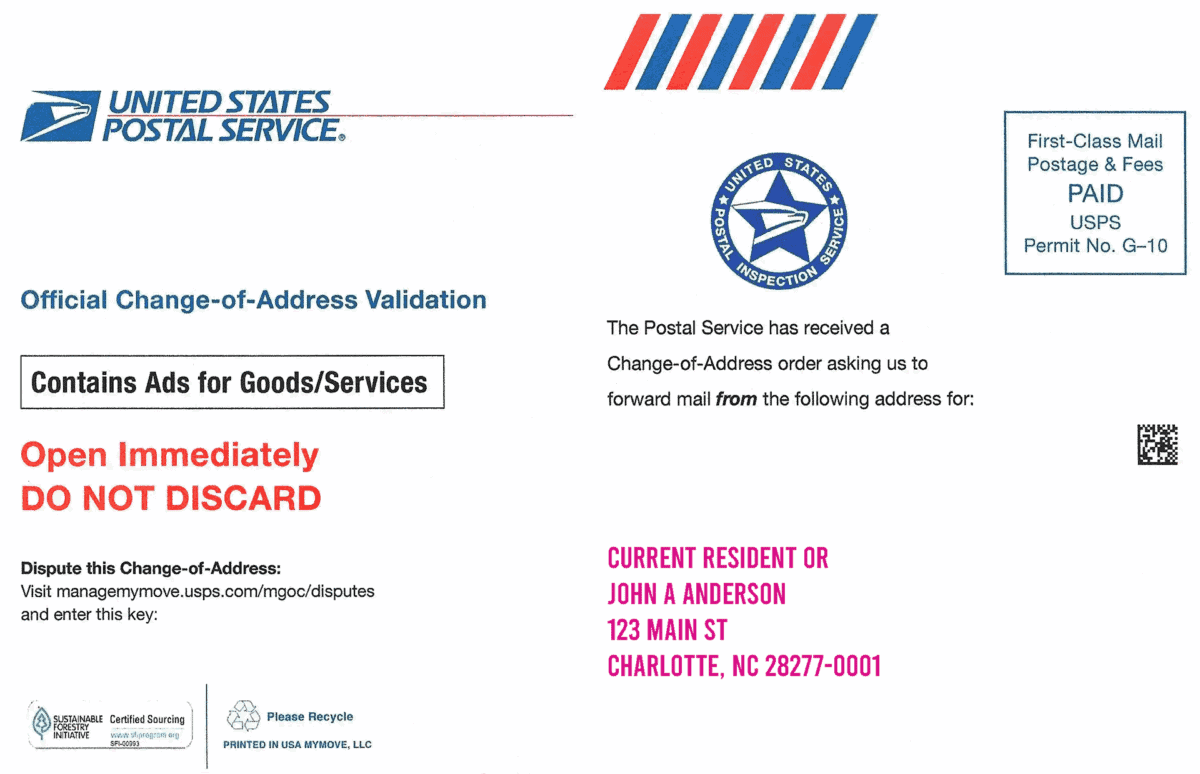
Think of it as USPS asking:
Did you really do this?
If someone's trying to hijack your mail, this is your red flag.
Here's what freaks people out most…
You move, and someone at your old address gets the Move Validation Letter. People think:
Can they cancel my forwarding? See my new address?
No. The letter only shows your name. It doesn't show your new address, and they can't interfere with a legitimate move.
Here's the flip side…
Homeowners get a Move Validation Letter for "Current Resident or Smith Family," who left ages ago. They panic:
This is fraud. Some stranger's gonna get my mail?
As long as it's not your name on the letter, there's nothing to worry about. Ignore the "Current Resident" boilerplate.
The "It's on like Donkey Kong" letter

About 5 business days before mail starts forwarding, a Customer Notification Letter arrives at your new address with a 16-digit confirmation code.
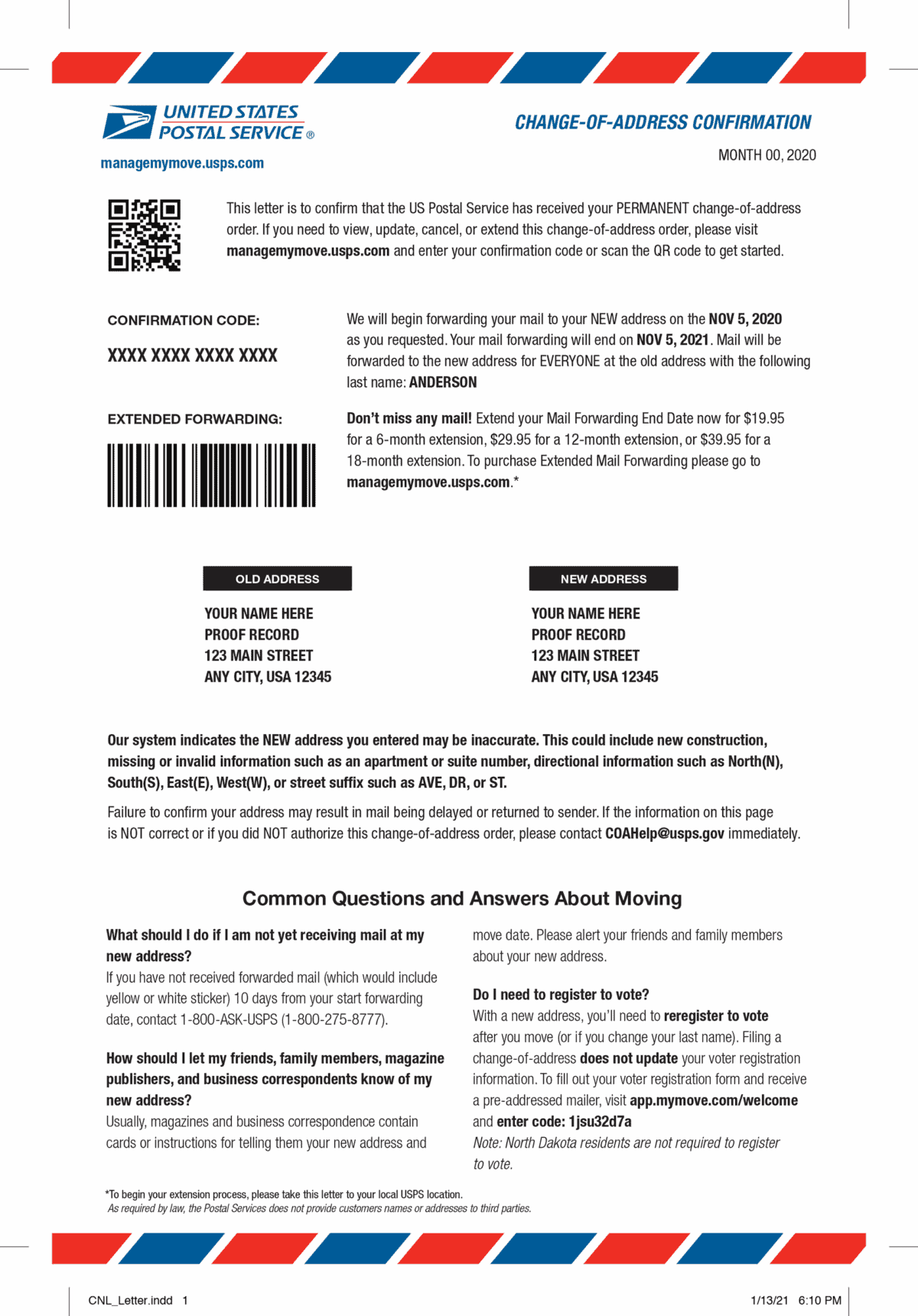
Guard that code like Fort Knox. It's your master key to manage your change of address online. Edit. Cancel. Extend. Total control.
Hot tip: File online to get your confirmation code instantly.
Wrap-up: Don't let your mail fall behind
Address and name change coming up? Don't forget USPS. Update both your old and new name with them.
Skip this step? Hello, mail chaos.
- Important letters bouncing back.
- Bills going missing.
- That tax refund stuck in postal limbo.
There's a lot to sort through. Individual or family forwarding? In person or online? Total forms? Extend or not? Confirmation code now or later?
Here's your USPS change of address checklist
- Choose family forwarding if eligible
- Apply online for faster processing
- Submit 2–3 COAs for past, present, and future names
- Skip the extension as it's not worth the cost
- Get your confirmation code immediately by filing online
Changing your name doesn't stop with USPS. Our online name change kit helps you handle the rest. From social security to passports, all in one place.
8 Comments